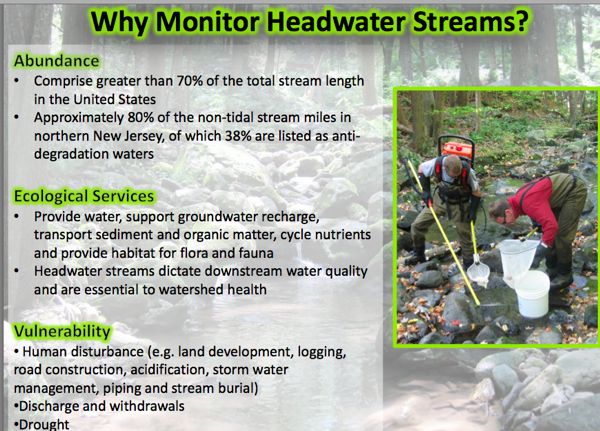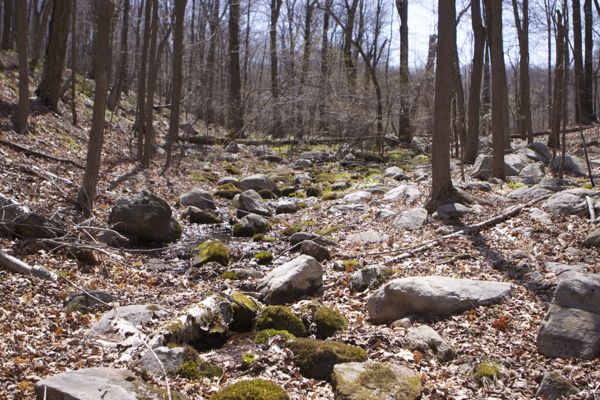Science Exposes Reckless Category One and Highlands Rollbacks
Never before has the DEP’s science so clearly contradicted the agency’s regulatory policy
Brian Henning, a scientists with DEP’s Bureau of Freshwater & Biological Monitoring, recently presented a new methodology for assessing water quality and the ecological health of headwater streams (you can review the powerpoint here).
The new method, called the Headwaters Index of Biotic Integrity (HIBI), builds on other DEP biological water quality assessment methods, including those based on macro-invertebrates and fish.
The HIBI is based on research begun over a decade ago, as part of the McGreevey/Campbell DEP’s clean water protection initiatives, specifically to strengthen and expand the DEP’s “integrated ecological assessment” developed for designation of individual Category One waters to a broader regional water quality monitoring program under the Clean Water Act. 
Note the vulnerability of these sensitive headwater streams to human disturbances like:
- land development (more allowed in Highlands under proposed septic density rollback)
- logging and road construction (like on Sparta Mountain & Highlands forests)
- stream buffer disturbance (more allowed under proposed Flood Hazard rules)
- stormwater management (impervious surface & stormwater from WQMP rollbacks)
- water withdrawals (Gov.’s Office still blocking release of Water Supply Plan)
- drought (No DEP plan to adapt to climate change, which will increase drought impacts)
According to DEP, the new HIBI can be used for the following:
Note especially the fact that “high gradient headwater streams” are located predominantly in the Highlands, a region that the Christie Administration is seeking to rollback protections and promote more development.
Note also the use for Category One designations – an important wate resource protection program that the Christie DEP has killed, despite recommendations by DEP scientists that the C1 program be expanded.
In an incredible irony, the decade long effort to finalize and implement the HIBI comes when the Christie DEP is systematically rolling back protections for headwater streams and has killed the C1 stream designation program
Never before has the DEP’s science so clearly contradicted the agency’s regulatory policy.
And that is a totally unacceptable and remarkably sad story.
The above provides more than sufficient information and a basis to sustain the pending Legislative veto of the Flood Hazard/C1 rollback proposal, to prompt another veto of the proposed Highlands septic density rollbacks, and to trigger legislative oversight hearings to expose the insanity underway in the Christie DEP.
Is anyone in Trenton or the media paying attention?
[End Note: And where are all those Foundation, corporate, and DEP funded watershed groups and their “citizen science” programs and large “communications” staffs in making these arguments to the public, the media, and Legislative policymakers?
Their silence is deafening – which is precisely why they remain so well funded.]

This is an “exceptionally ecologically significant” Category One (C1) trout production (TP) headwater stream. Notice that it has no defined stream bed and bank. Current DEP “Special Water Resource Protection Areas” regulations provide a 300 foot wide buffer protection. The DEP proposed to repeal and eliminate those protections. The new DEP “riparian zone” rules do not apply to headwater streams with no defined bed and bank.



Pingback: WolfeNotes.com » Christie DEP’s “Concurrent Proposal” to “Fix” Flood Hazard Rules to Avoid Legislative Veto Is A Sham
Pingback: WolfeNotes.com » Stories and Photos From 2016 – Part 2 (of 4)
Pingback: bb0009/
Pingback: WolfeNotes.com » Powerful Clean Water Tools Were Totally Ignored In NJ Spotlight Delaware Watershed Story